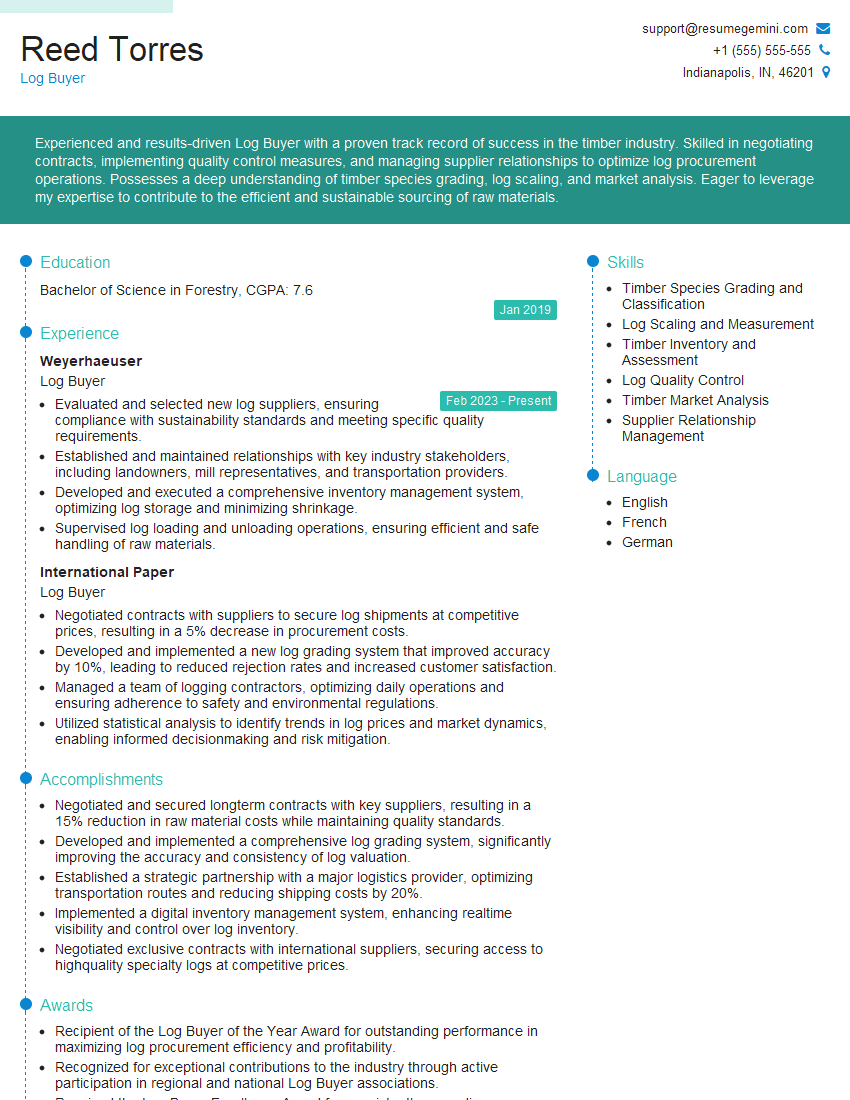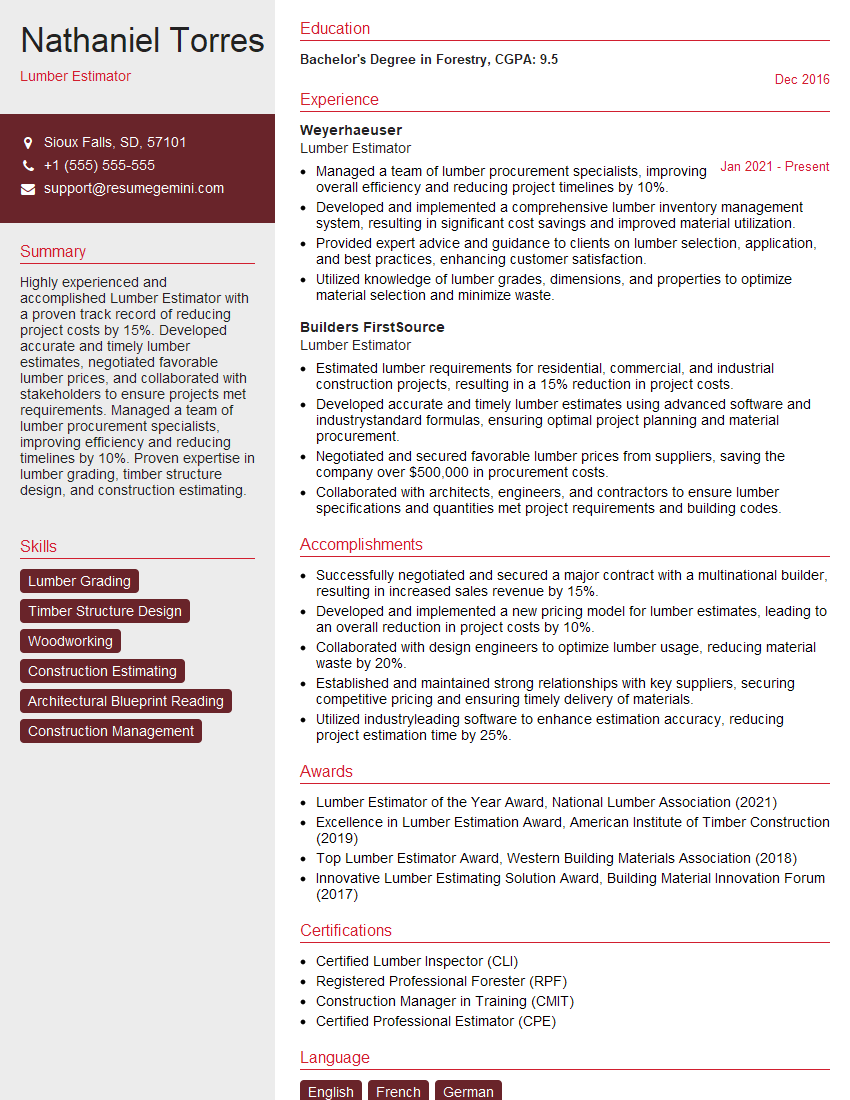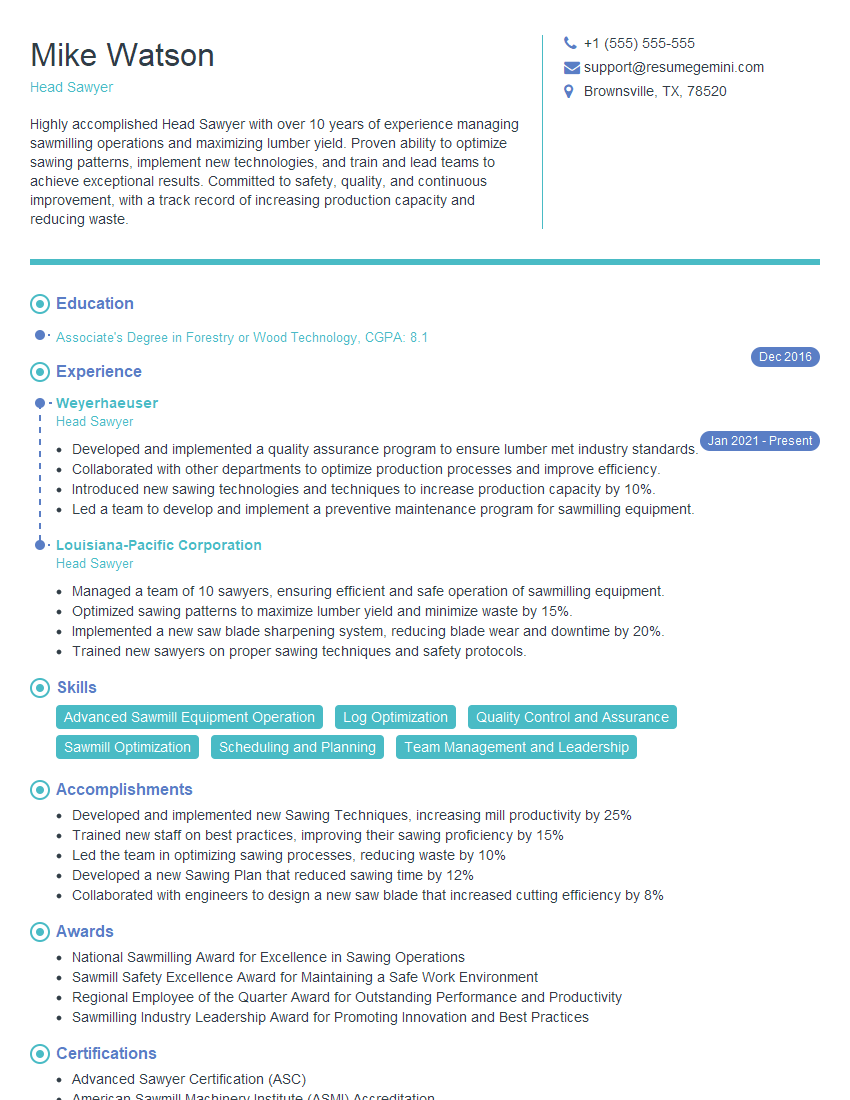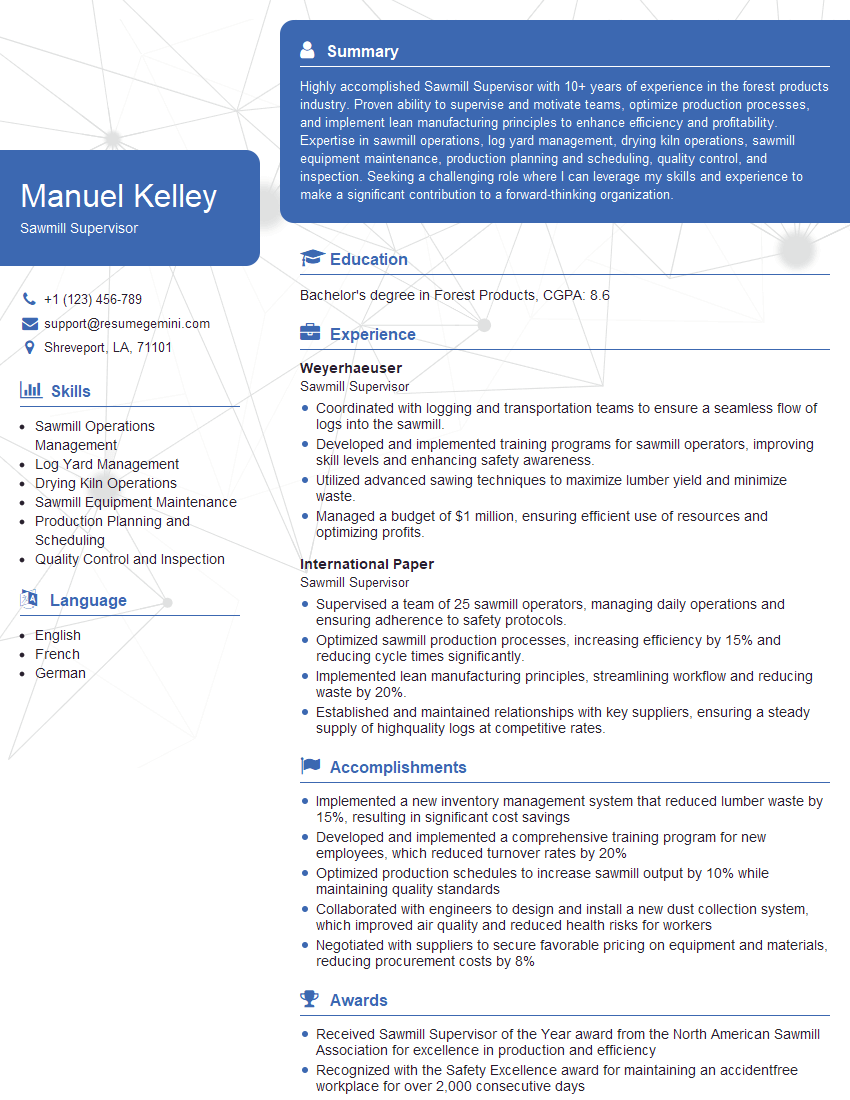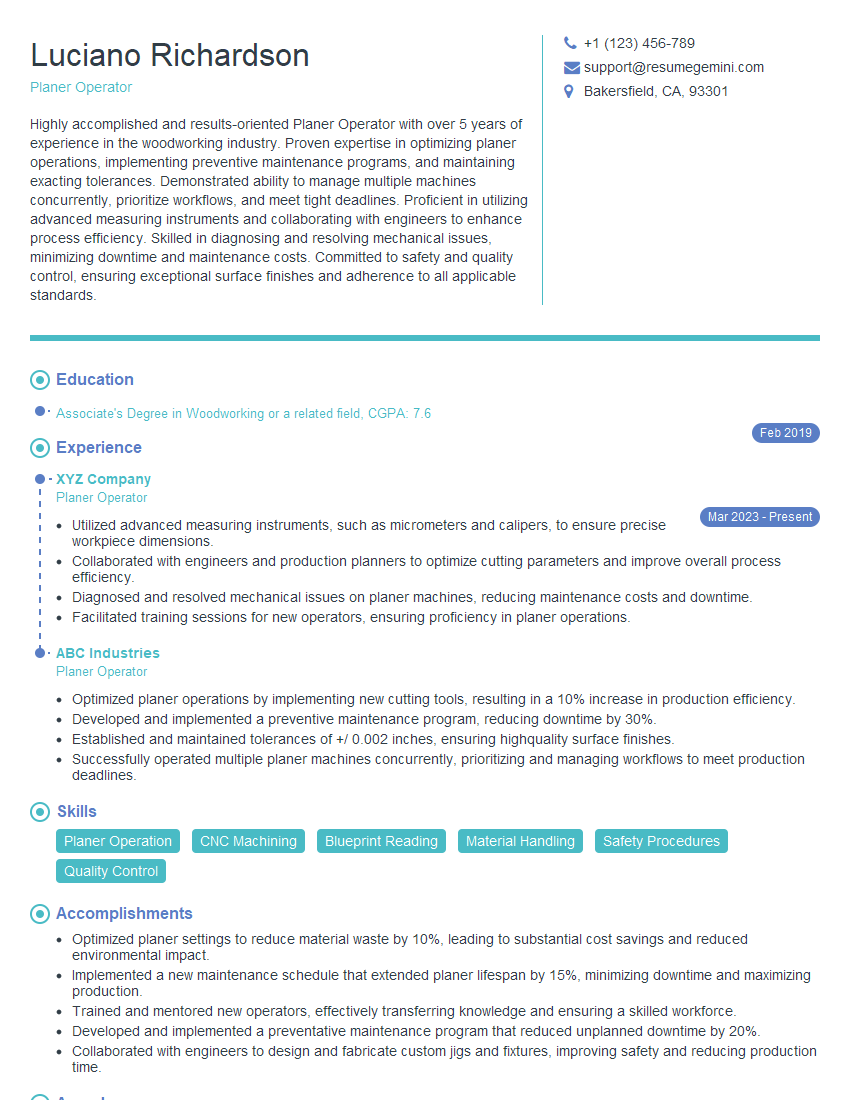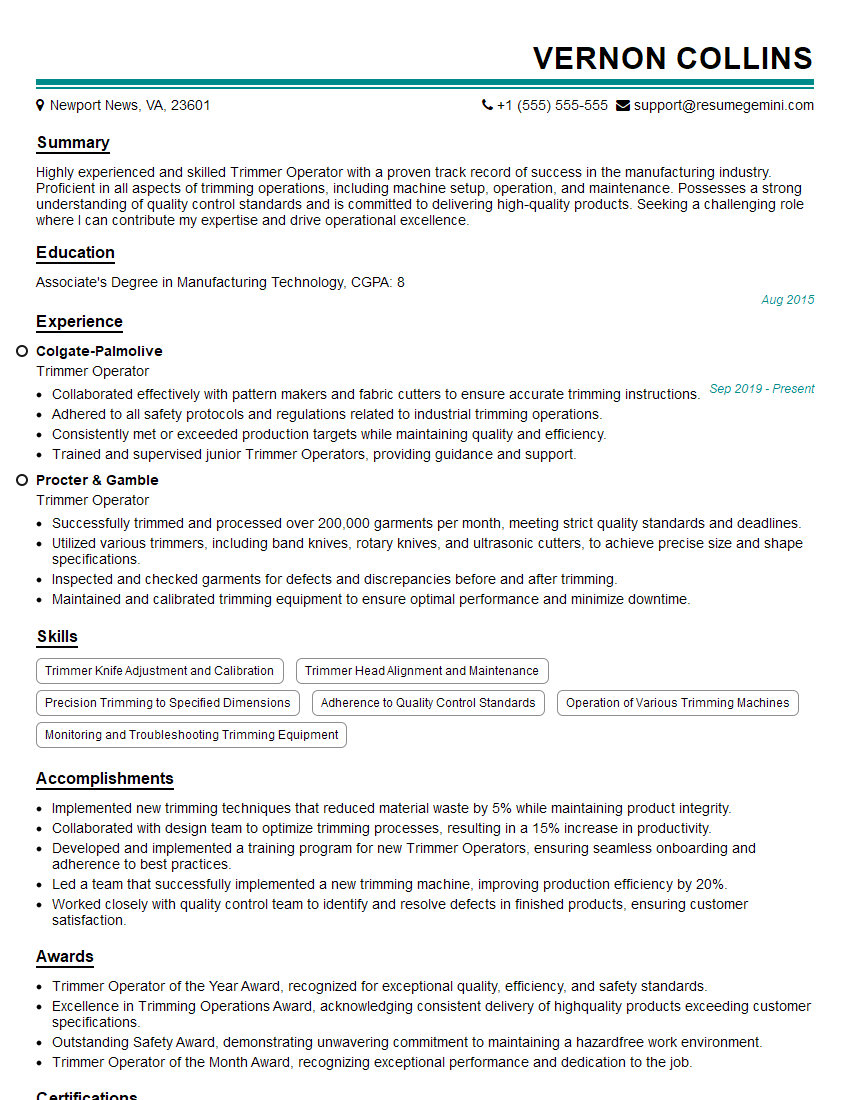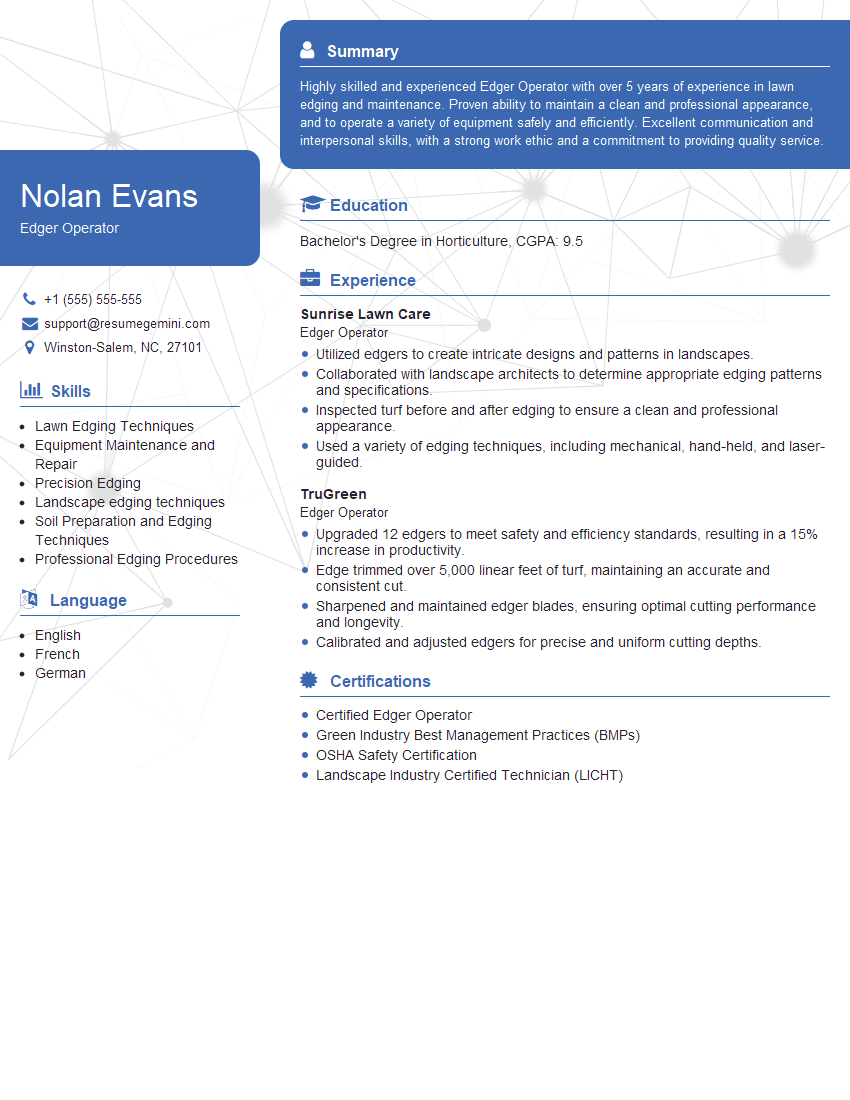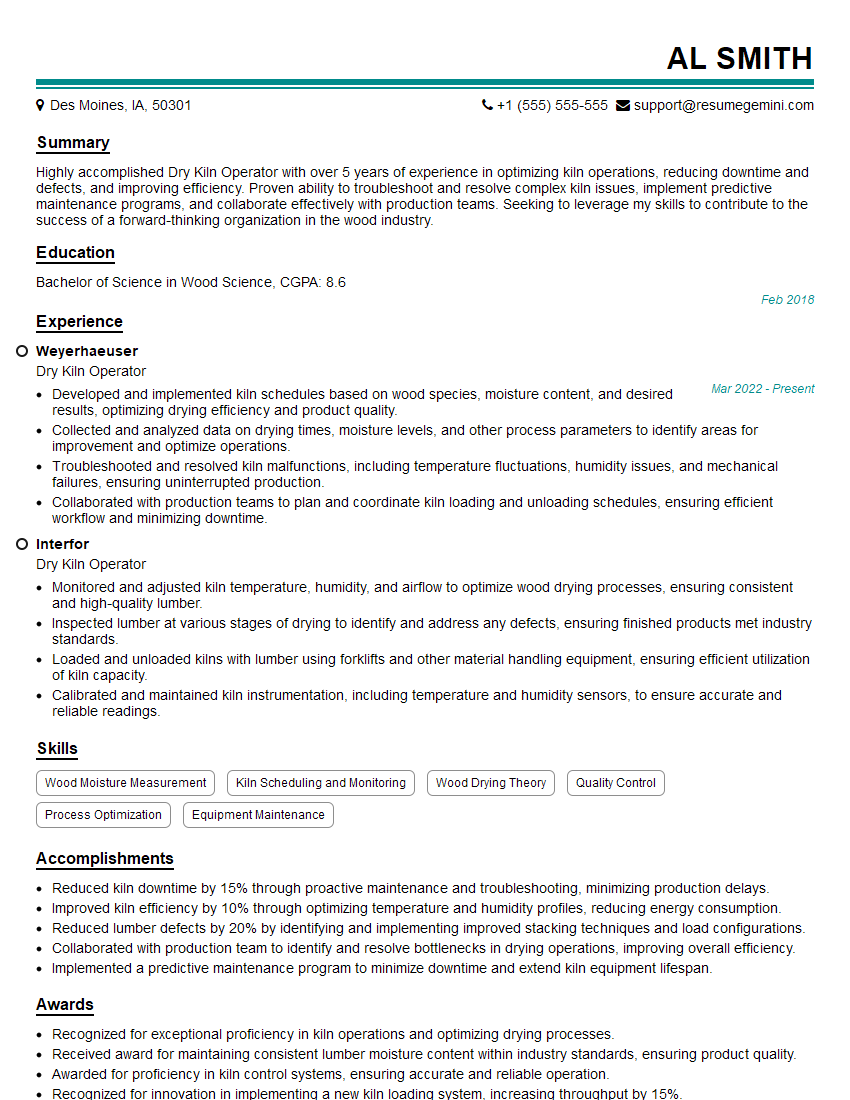Preparation is the key to success in any interview. In this post, we’ll explore crucial Lumber Milling interview questions and equip you with strategies to craft impactful answers. Whether you’re a beginner or a pro, these tips will elevate your preparation.
Questions Asked in Lumber Milling Interview
Q 1. Explain the different lumber grading rules.
Lumber grading rules are designed to standardize the quality of lumber based on its appearance, strength, and intended use. Different organizations, like the American Lumber Standard Committee (ALSC), establish these rules. Grades are assigned based on the presence and severity of defects such as knots, checks, splits, and decay. Higher grades generally mean fewer defects and increased strength, suitable for applications requiring high structural integrity, like framing a house. Lower grades, while having more imperfections, are still suitable for projects where appearance is less critical, like fencing or pallets.
- Structural Grades: These grades, such as No. 1 and No. 2, focus on strength and are used for load-bearing applications. They have strict limits on defects that could compromise structural integrity.
- Appearance Grades: These grades, like Select and Common, prioritize the visual quality of the wood. Defects are still allowed but are more tightly controlled in higher grades. This is important for things like furniture or flooring where aesthetic appeal is key.
- Specialty Grades: Some species have specialty grades for specific purposes, like clear grades for veneer or grades for timbers with specific strength requirements.
Imagine ordering lumber for a house: you’d want high structural grades for the main beams and framing. But for the less-visible parts of the house, lower grades might suffice. The grading system ensures you’re getting the appropriate quality for the price and intended use.
Q 2. Describe the process of debarking logs.
Debarking is the process of removing the bark from logs before milling. Efficient debarking is crucial for protecting sawmill equipment from damage and ensuring the production of high-quality lumber. There are several methods, each with its own advantages and disadvantages:
- Ring Debarkers: These use rotating drums with sharp elements that scrape the bark off. They’re efficient for large volumes but can cause damage if not properly adjusted.
- Drum Debarkers: Similar to ring debarkers, but the logs tumble within a rotating drum. More gentle on the wood, but less effective on certain types of bark.
- Hydraulic Debarkers: These use powerful hydraulic arms to peel the bark from the log. They’re highly adaptable to different log sizes and shapes, making them ideal for a mixed species operation.
- Manual Debarking: Though less common in large-scale operations, manual debarking can be necessary for smaller logs or specialized situations. This requires specialized tools and significant labor, making it less cost effective.
The choice of method depends on factors such as log size, species, and the mill’s capacity. A well-maintained debarking system is essential for minimizing wood loss and maximizing efficiency.
Q 3. What are the common types of sawmill defects?
Sawmill defects can significantly impact the grade and value of lumber. These defects originate from various sources, including tree growth patterns, logging practices, and milling processes. Some common defects include:
- Knots: Branches embedded in the wood, reducing strength and impacting appearance. Size, tightness, and position affect the grade.
- Checks: Small cracks that often run along the grain of the wood, resulting from stresses during drying. They are usually more superficial than splits.
- Splits: Larger cracks that extend deeper into the wood, often originating from stress or damage during harvesting.
- Decay: Damage caused by fungi, reducing wood strength and affecting its appearance.
- Shake: Separation of wood fibers along the grain, weakening the wood.
- Wane: The presence of bark or lack of wood on the edges of a board.
- Pitch Pockets: Accumulations of resin in the wood, potentially weakening the surrounding fibers.
Identifying and understanding these defects is essential for lumber graders to accurately assess the quality and assign appropriate grades.
Q 4. How do you identify different wood species?
Identifying wood species requires a combination of visual inspection and sometimes more advanced techniques. Visual characteristics include:
- Color: Different species have distinct colors and grain patterns. For example, oak tends to have a light brown color, while cherry often displays reddish-brown tones.
- Grain Pattern: The arrangement of wood fibers creates unique patterns. Straight grain is common in many species, while some like curly maple have distinctive swirls.
- Texture: The surface feel and density of the wood vary significantly across species. Some woods are smooth, while others are rough or coarse.
- Smell: Certain woods have a distinctive aroma, like cedar or pine. This is a less reliable identification method on its own, but can be a helpful clue.
More advanced techniques like microscopic examination or chemical analysis might be necessary in ambiguous cases or for distinguishing closely related species. Experience is key in wood identification, and lumber professionals often develop an eye for detail that allows them to quickly identify many species.
Q 5. Explain the operation of a band saw.
A band saw is a woodworking machine that uses a long, thin, continuous blade to cut wood. It’s known for its ability to make smooth, precise cuts, particularly in curved or intricate shapes. The blade, which is often made of high-speed steel, runs around two wheels, one of which is driven by a motor. The tension on the blade, speed, and the blade’s teeth all impact how well it cuts the wood.
The operation involves feeding the wood against the moving blade, controlling the feed rate to achieve the desired cut quality. The precise movement of the wood is critical for creating accurate cuts, especially on complex designs. Band saws are versatile, used in various applications, from rough cutting logs into boards to creating fine details in furniture and cabinetry. Safety precautions like proper blade tension, guarding, and proper feeding techniques are crucial to prevent accidents.
Q 6. Describe the drying process for lumber.
Drying lumber is a critical step to prevent decay, warping, and shrinkage. The goal is to reduce the moisture content to a level suitable for the intended application, typically around 6-12%. The process reduces the wood’s susceptibility to fungal growth and stabilizes its dimensions. Improper drying can lead to significant problems, including cracking, splitting, and checking, ultimately decreasing the value of the lumber.
Drying is controlled carefully to minimize these risks. The process usually starts with air drying, allowing for the gradual removal of moisture, followed by kiln drying to reach the desired moisture content. Monitoring throughout the process is important to ensure the wood dries evenly and does not undergo excessive stress.
Q 7. What are the different methods of lumber drying?
There are several methods for drying lumber, each with its strengths and weaknesses:
- Air Drying: This is a natural method where lumber is stacked outdoors under controlled conditions to allow gradual moisture loss through evaporation. It’s economical but slow, taking months or even years, depending on climate and wood species.
- Kiln Drying: This accelerated method involves placing lumber in a controlled environment where temperature and humidity are precisely regulated to speed up the drying process. Kilns can be of various types, using steam, air circulation, or vacuum systems. It’s faster than air drying, but requires specialized equipment and precise control to prevent damage to the lumber.
- Solar Drying: A more sustainable approach utilizing solar energy to heat the lumber. While it is environmentally friendly, it’s influenced by weather conditions and might not be practical in all regions.
The choice of method depends on factors like the species, desired quality, time constraints, and available resources. Many operations use a combination of air drying and kiln drying to achieve the best results.
Q 8. What are the safety procedures related to operating a chainsaw?
Chainsaw safety is paramount in lumber milling. Think of it like this: a chainsaw is a powerful tool that can inflict serious injury in seconds if not handled properly. Therefore, a multi-layered approach to safety is crucial.
- Personal Protective Equipment (PPE): Always wear safety glasses, hearing protection, steel-toed boots, chainsaw chaps (leg protection), and a hard hat. This is non-negotiable. Imagine working without them – a single slip could have devastating consequences.
- Proper Technique: Maintain a firm grip, use the correct cutting angle for felling, bucking, and limbing. Never reach over the chain. Think of the chain as an extension of your arm; control it, don’t let it control you.
- Pre-Operational Checks: Before each use, thoroughly inspect the chainsaw for damage, ensure the chain is properly tensioned and lubricated, and that the chain brake is functioning correctly. A dull chain requires more force and increases risk.
- Environmental Awareness: Be aware of your surroundings. Avoid working near overhead hazards, unstable ground, or in bad weather. Always have a clear escape route planned. Imagine a tree falling unexpectedly – having a safe space to retreat is vital.
- Maintenance: Regular maintenance is key. Keep the chainsaw sharp, clean, and well-maintained to ensure optimal performance and safety. A well-maintained saw is a safe saw.
Following these procedures is not just about rules; it’s about protecting yourself and your colleagues. A safe work environment leads to higher productivity and a longer, healthier career.
Q 9. How do you maintain a dry kiln?
Maintaining a dry kiln is a crucial aspect of lumber production, ensuring high-quality, durable wood. Think of it as a delicate balance – controlling the environment to perfectly dry the wood without causing damage.
- Regular Inspections: Daily checks of temperature, humidity, and air circulation are essential. Monitoring these parameters is like monitoring the vital signs of a patient; any deviation needs immediate attention.
- Cleaning: Regular cleaning prevents the buildup of sawdust and debris, which can affect airflow and the even distribution of heat. A clean kiln is a more efficient kiln.
- Sensor Calibration: Accurate readings are critical. Regular calibration of temperature and humidity sensors ensures accurate control of the drying process. This prevents inconsistent drying and potential wood damage.
- Preventative Maintenance: This involves regular checks and lubrication of all moving parts, such as fans and motors. Regular maintenance prevents costly breakdowns and extends the lifespan of your equipment. Think of it as regular car maintenance – it prevents larger, more expensive problems down the road.
- Steam System Maintenance: In steam kilns, the steam generation system requires regular cleaning and maintenance to ensure efficient and consistent steam production. A healthy steam system ensures consistent drying.
Effective dry kiln maintenance isn’t just about preventing costly repairs; it’s about producing consistent, high-quality lumber that meets industry standards. Consistency translates to better customer satisfaction and improved profitability.
Q 10. What are the common problems encountered in lumber drying?
Lumber drying can be tricky; numerous problems can arise if not managed effectively. These issues range from minor imperfections to significant defects impacting quality and value.
- Case Hardening: This occurs when the outer layers of the lumber dry faster than the interior, resulting in stresses and cracking. It’s like trying to squeeze a balloon – the pressure builds until it bursts.
- Check Cracking: These are splits that form during drying, usually along the wood’s growth rings. They’re a result of uneven shrinkage and internal stresses.
- Honeycombing: This is the formation of internal voids within the lumber due to excessive drying rates, leaving weak areas in the wood. Imagine Swiss cheese – full of holes and not as strong.
- Warping: This refers to the distortion of shape due to uneven moisture content distribution. It can manifest as cupping, bowing, or twisting. This reduces the usability of the lumber.
- Mold and Fungi: Improper drying conditions can lead to mold and fungal growth, compromising the lumber’s quality and potentially causing health issues.
Preventing these issues requires careful control of temperature, humidity, and air circulation throughout the drying process. It’s a balancing act between drying speed and preventing damage to maintain the quality and value of the lumber.
Q 11. Explain the use of a planer.
A planer is a woodworking machine used to smooth and flatten lumber. Think of it as a very precise, high-powered sander. It uses rotating cutters to remove thin layers of wood from the surface, resulting in a smooth, even finish.
Planers are used for various purposes, including:
- Surface Planing: This involves smoothing the surface of rough-sawn lumber to remove irregularities and create a flat, even surface.
- Thickness Planing: This process reduces the thickness of the lumber to a precise dimension, ensuring uniformity across all pieces.
- Joint Creation: Planers can create smooth, even edges and faces on lumber, enabling accurate joinery work.
The process involves feeding the lumber through the planer, adjusting the depth of cut to achieve the desired thickness or smoothness, and then collecting the planed lumber. Different types of planers are available, each suited for specific applications.
Q 12. How do you determine the moisture content of lumber?
Determining moisture content is crucial in lumber milling because it directly impacts the wood’s stability, strength, and susceptibility to defects. There are several methods:
- Moisture Meter: This is the most common method. A moisture meter uses electrical resistance or pin-type probes to measure the moisture content within the wood. Different meters are available for different wood types and applications.
- Oven-Drying Method: This involves weighing a sample of lumber, drying it in an oven at a specific temperature until it reaches constant weight, and then calculating the moisture content based on the weight loss. This is a more precise but time-consuming method.
- Weight Method: This method relies on measuring the weight difference between green lumber and oven dry lumber. Requires accurate weighing.
The chosen method depends on the accuracy required, the number of samples, and the available resources. Accurate moisture content determination is vital for ensuring product quality and avoiding issues like warping and cracking during the drying or milling process.
Q 13. What is the difference between hardwood and softwood?
The distinction between hardwood and softwood lies primarily in their botanical classification and resulting properties, not necessarily their actual hardness. Think of it like comparing apples and oranges.
- Hardwoods: These come from deciduous (broadleaf) trees that lose their leaves annually. They generally have a denser structure, more intricate grain patterns, and are harder and more durable than softwoods. Examples include oak, maple, cherry.
- Softwoods: These come from coniferous (needle-leaf) trees that retain their needles year-round. They typically have a simpler, more uniform grain structure, are softer, and are often easier to work with. Examples include pine, fir, spruce.
The terms ‘hardwood’ and ‘softwood’ can be misleading since some softwoods (e.g., yew) can be harder than some hardwoods (e.g., balsa). The distinction is primarily based on the tree’s botanical structure and not solely on the wood’s physical hardness.
Q 14. Explain the process of log sorting and scaling.
Log sorting and scaling are crucial steps in lumber production that ensure efficient processing and accurate measurement of lumber yield. It’s like organizing a warehouse – optimizing space and knowing what you have.
- Log Sorting: This involves classifying logs based on species, diameter, length, and quality. Logs are often sorted into different piles based on their intended use (e.g., lumber, pulpwood). This ensures efficient processing through the sawmill.
- Log Scaling: This is the process of determining the volume of each log to calculate the total lumber yield. Traditional methods involve using a scale stick or Doyle rule (a formula to estimate the volume), while modern methods utilize computerized scanning systems to provide highly accurate measurements.
Efficient sorting and scaling are critical for optimizing mill operations, determining profitability, and managing inventory. Accurate scaling helps determine the cost of logs and the value of the lumber produced.
Q 15. Describe the different types of lumber cuts (e.g., plain sawn, quarter sawn).
Lumber cuts refer to the orientation of the saw cut relative to the growth rings of the log. Different cuts produce boards with varying characteristics in terms of grain pattern, strength, and stability. The most common types are plain sawn, quarter sawn, and rift sawn.
- Plain Sawn (also called flat sawn or slash sawn): This is the most common and economical cut. The saw cuts are made parallel to the growth rings, resulting in boards with a wider range of grain patterns. This can lead to more pronounced cup or warp and can be susceptible to checking (cracking along the grain). Think of it like slicing a loaf of bread – you get a lot of slices but some might be uneven.
- Quarter Sawn: This method involves cutting the log into quarters before sawing. The saw cuts are made perpendicular to the growth rings, producing boards with a more uniform, straight grain pattern. This results in greater dimensional stability and resistance to warping and checking than plain sawn lumber; however, it produces less yield. Imagine cutting a pie into quarters before slicing each quarter – you get fewer but more consistent slices.
- Rift Sawn: This is a more precise variation of quarter sawing where the saw cuts are made radially (from the center of the log to the outside), resulting in an exceptionally straight grain. This is highly prized for its stability and strength but is the least efficient cut and results in the lowest yield.
The choice of cut depends on the intended use of the lumber. Plain sawn is suitable for general construction where cost-effectiveness is prioritized. Quarter sawn and rift sawn are preferred for applications where stability and durability are critical, such as flooring, furniture making, and musical instruments.
Career Expert Tips:
- Ace those interviews! Prepare effectively by reviewing the Top 50 Most Common Interview Questions on ResumeGemini.
- Navigate your job search with confidence! Explore a wide range of Career Tips on ResumeGemini. Learn about common challenges and recommendations to overcome them.
- Craft the perfect resume! Master the Art of Resume Writing with ResumeGemini’s guide. Showcase your unique qualifications and achievements effectively.
- Don’t miss out on holiday savings! Build your dream resume with ResumeGemini’s ATS optimized templates.
Q 16. What are the factors that influence lumber yield?
Lumber yield, the amount of usable lumber obtained from a log, is significantly impacted by several factors. Maximizing yield is crucial for profitability.
- Log Size and Quality: Larger, straighter logs with fewer defects yield more lumber. Knots, rot, and other imperfections reduce the amount of usable material.
- Sawing Method and Pattern: The choice of sawing technique (plain sawn, quarter sawn, etc.) directly affects yield. Plain sawing maximizes yield but may result in lower-quality boards. More precise cuts reduce waste but decrease the overall volume of lumber.
- Sawmill Equipment and Technology: Modern, efficient sawmills with optimized blade settings and computer-aided sawing patterns minimize waste and improve yield.
- Skill of the Mill Operator: Experienced operators can make better decisions about log orientation and sawing patterns, maximizing the recovery of usable lumber.
- Log Species: Different tree species have varying characteristics affecting yield. Some species are more prone to defects, reducing their usable lumber.
For example, a sawmill using advanced scanning technology to identify defects before cutting can significantly improve yield compared to a sawmill relying solely on manual assessment. Effective log sorting and management are also crucial for yield optimization.
Q 17. How do you manage lumber inventory efficiently?
Efficient lumber inventory management is essential for minimizing storage costs, preventing losses from deterioration, and ensuring timely fulfillment of orders. A well-structured system involves several key elements:
- Organized Storage: Lumber should be stored in a dry, well-ventilated area, protected from the elements. Proper stacking techniques, using separators to allow for airflow, are crucial to prevent warping and mold growth. Different grades and species should be clearly identified and separated.
- Inventory Tracking System: A computerized system is ideal for accurate tracking of lumber quantities, dimensions, grade, and species. This allows for real-time monitoring of stock levels and helps in forecasting future needs.
- First-In, First-Out (FIFO) System: Implementing a FIFO system ensures that older lumber is used first, minimizing the risk of deterioration or obsolescence.
- Regular Inventory Audits: Periodic physical checks should be conducted to verify inventory levels and identify discrepancies between physical stock and recorded data.
- Demand Forecasting: Analyzing historical sales data and market trends can help predict future demand, enabling proactive inventory management and avoiding stockouts or overstocking.
Investing in barcode scanning or RFID technology can further improve accuracy and efficiency in inventory tracking. For instance, knowing exactly where and how much of each lumber type you have, you can quickly fulfill custom orders and minimize waste from excess inventory.
Q 18. Explain the importance of quality control in lumber milling.
Quality control is paramount in lumber milling, directly impacting the reputation and profitability of the mill. It involves rigorous checks at various stages of the process:
- Log Selection: Careful inspection of logs to identify defects and ensure they meet the required standards.
- Sawing Process: Monitoring the sawing operation to ensure proper alignment, blade sharpness, and cut quality. This prevents defects and ensures consistent dimensions.
- Grading and Sorting: Classifying lumber based on quality standards such as the National Hardwood Lumber Association (NHLA) grading rules. This involves assessing factors like knots, checks, and other imperfections.
- Drying Process: Controlling the kiln drying process to prevent defects like warping, checking, and degrade. This maintains the quality and stability of the lumber.
- Final Inspection: A thorough inspection of the finished lumber before shipment to ensure it meets customer specifications and quality standards.
Failure to maintain quality control can result in significant financial losses from defects, customer complaints, and damaged reputation. A robust quality control system ensures customer satisfaction and safeguards the mill’s reputation for producing high-quality lumber.
Q 19. What are the common maintenance procedures for sawmill equipment?
Regular maintenance of sawmill equipment is crucial for preventing breakdowns, ensuring safety, and maintaining optimal productivity. A comprehensive maintenance program includes:
- Daily Inspections: Visual checks of all equipment for signs of wear, damage, or loose parts. This includes checking belts, chains, lubrication levels, and blade alignment.
- Regular Lubrication: Applying lubricants to moving parts as per the manufacturer’s recommendations to reduce friction and wear.
- Blade Sharpening and Replacement: Regular sharpening of saw blades to maintain cutting efficiency and prevent damage to the lumber. Replacing worn or damaged blades promptly.
- Preventive Maintenance: Scheduled maintenance activities such as cleaning, inspecting, and replacing components before they fail. This includes checking hydraulic systems, electrical components, and bearings.
- Operator Training: Training sawmill operators on proper equipment operation and maintenance procedures to prevent misuse and damage.
A well-maintained sawmill operates more efficiently, produces higher-quality lumber, and minimizes downtime due to unexpected repairs. A preventive maintenance schedule, meticulously followed, is far more cost-effective than emergency repairs.
Q 20. How do you troubleshoot common sawmill equipment malfunctions?
Troubleshooting sawmill equipment malfunctions requires systematic problem-solving. Here’s a general approach:
- Safety First: Always prioritize safety before attempting any repair. Shut down the equipment and isolate power sources.
- Identify the Problem: Determine the specific malfunction. Listen for unusual noises, observe unusual behavior, and check error messages (if any).
- Consult Manuals and Documentation: Refer to the equipment’s manuals for troubleshooting guides, diagrams, and specifications.
- Check Basic Components: Inspect belts, chains, pulleys, and other simple components for wear, breakage, or misalignment.
- Check Lubrication and Hydraulic Systems: Ensure proper lubrication levels and inspect hydraulic systems for leaks or blockages.
- Check Electrical Systems: Inspect wiring, connections, and control components for faults.
- Seek Expert Assistance: If the problem persists, contact a qualified technician or the equipment manufacturer for assistance.
For example, if a saw blade is vibrating excessively, it might be due to dull blades, misalignment, or worn bearings. A systematic approach, checking each component, will help isolate the cause and allow for efficient repair.
Q 21. Describe your experience with different types of sawmill blades.
My experience encompasses various sawmill blade types, each with its own strengths and limitations:
- Circular Saw Blades: These are widely used for both ripping (cutting along the grain) and crosscutting (cutting across the grain). They offer versatility but require frequent sharpening and are prone to wear depending on the material and cut.
- Band Saw Blades: These are thinner and longer than circular blades, producing smoother cuts with less kerf (the width of the cut). They’re well-suited for curved cuts and producing high-quality lumber, but are more expensive and require specialized maintenance.
- Gang Saw Blades: Used in gang saws, these blades allow for simultaneous cutting of multiple boards from a log, increasing efficiency. They’re optimized for high-volume production but require precise alignment and maintenance.
- Different Tooth Configurations: Blades have varying tooth configurations (e.g., number of teeth, tooth shape, tooth spacing) that are selected based on the wood species, cut type, and desired cut quality. For example, harder woods often require blades with more teeth and a different tooth geometry than softer woods.
- Material Composition: Blades are made from different materials, including high-speed steel (HSS), carbide, and diamond, depending on the application and cost considerations. Carbide-tipped blades are exceptionally durable and long-lasting, while diamond blades are used for specialized cutting needs.
Choosing the right blade type and tooth configuration is critical for optimizing cutting efficiency, achieving desired cut quality, and minimizing blade wear. My experience allows me to make informed decisions based on specific job requirements.
Q 22. How do you ensure the safety of workers in a sawmill environment?
Sawmill safety is paramount. It’s not just about following regulations; it’s about fostering a safety-first culture. We achieve this through a multi-pronged approach.
Comprehensive Training: All employees, from seasoned veterans to new hires, undergo rigorous training on safe operating procedures for all machinery. This includes hands-on practice and regular refresher courses. For example, we use detailed simulations to practice emergency shutdowns on the debarker and headrig.
Regular Inspections and Maintenance: Preventive maintenance is crucial. We have a scheduled maintenance program for all equipment, including regular inspections for wear and tear, lubrication, and blade sharpness. A well-maintained saw is a safe saw.
Personal Protective Equipment (PPE): Providing and enforcing the use of appropriate PPE, including safety glasses, hearing protection, steel-toed boots, and hard hats, is non-negotiable. We emphasize the importance of proper fit and encourage employees to report any damaged or uncomfortable equipment immediately.
Emergency Response Plan: We have a detailed emergency response plan, including regular drills to ensure everyone knows what to do in case of an accident or fire. This plan includes first aid training and clear communication protocols.
Hazard Identification and Risk Assessment: We regularly conduct hazard identification and risk assessments to proactively identify and mitigate potential dangers. This is an ongoing process, and employee feedback is actively sought.
Ultimately, a safe sawmill is a productive sawmill. By prioritizing safety, we reduce accidents, boost morale, and improve our bottom line.
Q 23. What are the environmental considerations in lumber milling?
Environmental responsibility is integral to modern lumber milling. We minimize our impact through various strategies.
Sustainable Forestry Practices: We source timber from sustainably managed forests, ensuring responsible harvesting and reforestation efforts. This includes working with certified forestry organizations and adhering to strict guidelines for logging and replanting.
Waste Reduction and Recycling: We employ advanced milling techniques to maximize timber yield and minimize waste. Sawdust and wood chips are often used for biomass energy generation or sold to other industries, reducing landfill waste.
Water Management: We implement efficient water usage systems, minimizing water consumption during processing and employing wastewater treatment to prevent pollution. We monitor water quality regularly.
Air Quality Control: We utilize dust collection systems and other technologies to control air emissions from the milling process, reducing particulate matter and other pollutants. Regular monitoring ensures compliance with environmental regulations.
Responsible Disposal of Chemicals: Any chemicals used in the process, such as preservatives, are handled and disposed of according to strict environmental regulations, minimizing their impact on soil and water resources.
Our commitment to environmental sustainability not only benefits the planet but also enhances our reputation and contributes to long-term business success.
Q 24. How do you handle lumber waste and by-products?
Lumber waste and by-products are valuable resources, not just trash. Our approach focuses on maximizing their utilization.
Sawdust and Wood Chips: These are primarily used for biomass energy generation, providing a renewable energy source for our mill or sold to other industries for various applications like animal bedding or composite materials.
Bark: Bark can be used as mulch in landscaping or composted for soil amendment. Some mills even extract tannins from bark for use in tanning leather.
Debarking Residues: Depending on the species and condition, these can be burned in a controlled manner for energy production or composted.
Scrap Wood: Smaller pieces of wood that are not suitable for lumber may be used for pallets, firewood, or as raw material for other wood products.
Recycling Programs: We actively seek opportunities for recycling materials, such as metal scraps from machinery, plastics, and cardboard packaging.
A comprehensive waste management strategy not only minimizes environmental impact but also creates additional revenue streams and reduces operating costs.
Q 25. Explain your experience with different lumber processing software.
I have extensive experience with several lumber processing software packages, including:
CutOptimizer Pro: I’m proficient in using CutOptimizer Pro to optimize lumber yield by minimizing waste and maximizing the value of each log. I can develop and optimize cutting patterns based on specific log dimensions and customer order requirements. For example, I’ve used it to reduce waste by 15% in our hardwood operation.
TimberManager: I’m familiar with TimberManager for inventory management, tracking lumber from log procurement to finished product. This software allows for precise tracking of each log’s characteristics, optimizing inventory control and preventing loss.
LogMax: I have experience utilizing LogMax for optimizing log breakdown, including grade sorting and yield estimation. I can effectively integrate log data from scanning systems to improve the efficiency of the sawing process.
My experience extends beyond simply operating these software packages; I understand their underlying logic and can adapt them to specific mill configurations and production goals. I’m comfortable troubleshooting technical issues and training other employees on their use.
Q 26. What are your salary expectations for this role?
Based on my experience and the requirements of this role, my salary expectations are in the range of $[Lower Bound] to $[Upper Bound] per year. This is a figure I arrived at by considering my skills, industry standards, and the responsibilities associated with this position. I am, of course, open to discussing this further.
Q 27. What are your long-term career goals in the lumber industry?
My long-term career goals involve becoming a leader in sustainable lumber milling practices. I aspire to contribute to advancements in technology and efficiency while prioritizing environmental stewardship. I envision myself eventually managing a mill, implementing innovative solutions to improve productivity and minimize our environmental footprint. This includes exploring new technologies in wood processing and developing strategies for carbon sequestration within the lumber industry.
Q 28. Why are you interested in this specific lumber milling position?
I’m interested in this specific position because of [Company Name]’s reputation for both its commitment to sustainable practices and its innovative approach to lumber milling. The opportunity to contribute to a company that shares my values and offers a challenging and rewarding work environment is particularly appealing. I’m also excited by the prospect of working with your team and learning from experienced professionals within the industry.
Key Topics to Learn for Lumber Milling Interview
- Log Yard Operations: Understanding log sorting, storage, and handling techniques; the importance of efficient log flow and minimizing waste.
- Sawmilling Processes: Familiarization with different sawing methods (e.g., headrig, gang saw), understanding lumber grading rules and optimizing yield.
- Kiln Drying: Knowledge of various drying techniques and their impact on lumber quality; understanding moisture content control and its importance in preventing defects.
- Planing and Finishing: Familiarity with different planing and surfacing methods; understanding the role of finishing in enhancing lumber value and durability.
- Safety Procedures: Deep understanding of all relevant safety protocols within a lumber mill environment; demonstrating knowledge of hazard identification and risk mitigation strategies.
- Wood Species Identification: Ability to identify common wood species used in lumber production; understanding the properties and applications of different species.
- Maintenance and Troubleshooting: Knowledge of basic mill maintenance, identifying common equipment malfunctions, and practical problem-solving skills.
- Quality Control: Understanding quality control measures throughout the milling process; identifying and addressing lumber defects; adhering to industry standards.
- Sustainability and Environmental Impact: Awareness of sustainable forestry practices and environmental considerations within lumber production.
- Production Optimization: Understanding techniques for improving efficiency and reducing waste in lumber milling operations; application of lean manufacturing principles.
Next Steps
Mastering the intricacies of lumber milling opens doors to a rewarding career with excellent growth potential. Demand for skilled professionals in this field remains high, offering opportunities for advancement and specialization. To maximize your job prospects, it’s crucial to present your skills effectively. Creating an ATS-friendly resume is essential for getting your application noticed. ResumeGemini is a trusted resource that can help you build a professional and impactful resume. We provide examples of resumes tailored to the Lumber Milling industry to guide you through the process, ensuring your qualifications shine.
Explore more articles
Users Rating of Our Blogs
Share Your Experience
We value your feedback! Please rate our content and share your thoughts (optional).
What Readers Say About Our Blog
Hello,
We found issues with your domain’s email setup that may be sending your messages to spam or blocking them completely. InboxShield Mini shows you how to fix it in minutes — no tech skills required.
Scan your domain now for details: https://inboxshield-mini.com/
— Adam @ InboxShield Mini
Reply STOP to unsubscribe
Hi, are you owner of interviewgemini.com? What if I told you I could help you find extra time in your schedule, reconnect with leads you didn’t even realize you missed, and bring in more “I want to work with you” conversations, without increasing your ad spend or hiring a full-time employee?
All with a flexible, budget-friendly service that could easily pay for itself. Sounds good?
Would it be nice to jump on a quick 10-minute call so I can show you exactly how we make this work?
Best,
Hapei
Marketing Director
Hey, I know you’re the owner of interviewgemini.com. I’ll be quick.
Fundraising for your business is tough and time-consuming. We make it easier by guaranteeing two private investor meetings each month, for six months. No demos, no pitch events – just direct introductions to active investors matched to your startup.
If youR17;re raising, this could help you build real momentum. Want me to send more info?
Hi, I represent an SEO company that specialises in getting you AI citations and higher rankings on Google. I’d like to offer you a 100% free SEO audit for your website. Would you be interested?
Hi, I represent an SEO company that specialises in getting you AI citations and higher rankings on Google. I’d like to offer you a 100% free SEO audit for your website. Would you be interested?
good
